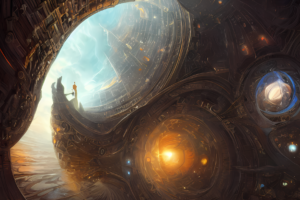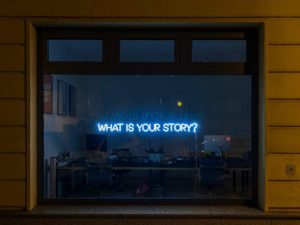Creating an image with AI

User generated image using Stable Diffusion
Stability AI and its collaborators announced the first stage of the release of Stable Diffusion to researchers. In short, AI creates images based on parameters you enter – words, sketches, collages and more. They’ve been testing the model at scale with over 10,000 beta testers that are creating 1.7 million images a day. That’s, well, staggering.
Does AI replace humans? Not at all. But it does amplify our ability to create and make at scale. And then there is this little gem where a person just won first prize (and the corresponding angst) at an art fair with a piece of AI-generated Art.
Creating Content in Notion
TL’DR: Don’t think of note-taking in Notion as about creating a note for every idea, piece of work, or event. Think about one note housing many notes within it. All are searchable and discoverable.
Notion is unlike most note-taking apps – because it isn’t one. It’s a database, essentially, but don’t let that put you off. But it does mean you can create notes differently.
Simply put, you can create depth to every note by creating pages within a page.
Here’s how it works. Let’s say I’m producing content for my company. Traditionally every piece of content might be a new note in say, Apple Notes or a document in Google Docs.
With Notion, I have a master list of all the content I am working on. Each of these appears in my master content page. As I develop that content, I simply create a new page within the content master. I share the master once with the team so they can see everything I am working on.
Then, with a click, I can convert that to a board view and develop a workflow on the fly, easily arranging the content by it’s stage of development. And I’ve got one central archive for all the content we have produced.
It’s also simple and easy to create templates in Notion, so you can quickly populate all the stuff you need to produce great content. This might include keywords, categories, affiliate links and more.
And, just get Grammarly – it works great with Notion.
Check out this Notion video from Thomas Frank or swim through the Notion YouTube channel.
Better Note Taking with Notion
TD’LR: You don’t need to pick one note-taking app, but you do need to choose your master app. Define a workflow and set rigour around it.
Angsty videos and medium posts on why folks selected a particular note-taking app mostly miss the real need – how to be productive, collaborate, and, well, forget less.
The answer is blindingly simple – take notes everywhere, anywhere, using anything. Just do it.
The tricks are:
- First: pick a master system – in my case, Notion – where all those thoughts and ideas can go to live.
- Second: define a simple workflow to get notes from wherever they were captured and into Notion. The tip here is to make it fast. So, I’ll drop a photo from a whiteboard into Notion rather than trying to recreate it.
- Third: establish a routine to get all your notes in one place. Every week I have a calendar block marked “download and clean” where everything goes into Notion. I even have a simple Notion checklist of everything I need to look at, from receipts buried in my bag to my notebook, Apple Photos and more.
So what about the notes capture? As I said, just do it.
Here are my big three:
- Old fashioned pen, paper and index cards. Scribble away, fuel that stationary fetish, and have fun. I use my iPhone to snag whiteboards, brainstorms and more.
- Use whatever digital app works best for you. Bear is an excellent app for catching notes on the go. Especially the voice capture on an Apple Watch. So, if I am driving home and recall something, I tap Bear on my phone and watch it automatically convert to a text note. Apple notes is OK but not great. But occasionally, I’ll sketch or punch a note in there.
- Notion is where everything goes and is shared. The point is not the storage in one place – that’s great and sometimes useful at a future date. The point is that through the process, I am creating secondary notes. So, I might capture notes from a team meeting that include a reference to check-in on headcount approvals – they sit in one Notion page for all my Day Notes. But I’ll also flow that action into my 1:1 Notes for the next meeting with our talent team. Equally important, Notion is the only place I share notes – so I have one place to collaborate from.
The underlying philosophy here is time to ingestion – the faster and more quickly you can capture a note, the more you’ll do it and the more productive you’ll be.
The leap in all this is the discipline and habit required. We’re defined by our routines and rituals. So for those struggling to do this, just do everything in Notion and work backwards.
Reads & Feeds
- You have no privacy, don’t get over it. So you’ve never read those epic terms and conditions that come with Google mail – and likely resigned yourself to having no privacy and the indiscriminate scanning of users’ cloud data. So what happens when you suffer the consequence of Big Tech looking at your email? This is a sobering story. In short, Mark, a man flagged by Google as a purveyor of Child Sexual Abuse Material (CSAM) for taking pictures of his son’s penis and sending them to their family doctor, subsequently lost nearly every aspect of his digital life when Google deleted his account. Read more over at the excellent Stratechery.
- JP Morgan paper on Big Data, AI & Machine Learning. An excellent summary of #MachineLearning #AI and #BigData #DataScience. And even an overview of types of alternative data and a brilliant tutorial on #ML methods to analyse data.
- Mckinsey says the Metaverse will generate up to $5 trillion in value by 2030 and is too big for companies to ignore.
Random but worth it:
- Bruce Mau is coming to Sydney. One of the many designers I admire. I can’t wait to see him speaking and the movie.
- A great set of resources for clearer thinking
- You’ve been waiting to hear this for like 3,400 years.
- This has to be the coolest fish ever…
TV Matters, Or Does It
Youtube’s most recent upfront reignited the debate around the relevance of TV and the much-maligned 30-second spot. Ritson counterbalanced the hyperbole with:
“I think most marketers these days agree that the reports of the death of linear TV have been wildly exaggerated. But nonetheless, we have to accept that a lot of people are watching a lot less linear TV than perhaps they once did,” said Ritson.
“That’s a major problem, especially for big brands who have for decades depended on linear TV to build their brands at the top of the funnel through its enormous reach. And that’s exactly where YouTube plays a wonderful role. As a supplement to linear TV, especially on connected televisions, YouTube provides a brilliant way to restore that reach, particularly among the younger demographics that have proven so difficult in recent years to reach out to.”
While Ritson is right, there are two problems with this.
First, the idea of a “top of the funnel” is antiquated. We are in need of the continuous creation of mental, physical and digital availability for our brands across all stages of the funnel. All buyers buy infrequently. The funnel is a broken metaphor. More to come on that.
Digital mediums – Youtube – plays a critical role in generating that availability. The issue is efficiency, effectiveness and reach. That is where the debate starts. So even if we are watching TV less – much less in my case – does that smaller viewing audience more efficiently and effectively create availability? I can’t recall a single ad or brand I’ve seen on Youtube but can recall brands I’ve seen on TV. Samples of one make for terrible evidence.
Second, drawing two mediums into a compare and delete debate is futile. The reality is all marketers of any quality will be working the media mix for outcomes. It’s not either, or – but rather where to allocate the spend across a mix. As more of us consume formats that move – TV, video, social the real losers will be static media. Not just in terms of the reach and efficiency of that media but also the complexity and cost in making that media work.
What is true is that we must adjust all marketing to reflect the attention span of audiences – short formats for intercepting the “feed” and much longer formats for engagement.
“Six second bumpers and 15-second spots. A smart mix can build a great story … languishing behind is the 30 and its cousin, the 45-second spot, which generate the lowest ROI across all screens … 30-seconds is too complex to automate, too simple to convince. It’s too short if I’ve chosen to engage with it, and it’s far too long if I’m forced to watch it. Consumers tend to skip the platform if they’re faced with the forced 30-second spot. Hence skippable format and the burst of the six second bumper. It’s long enough to grab my attention and over before I have the chance to object.”
The best performing ads, created by only 15 per cent of advertisers, were longer than three minutes, per Hunt.
So, go long, go short – but don’t get trapped in the middle.






